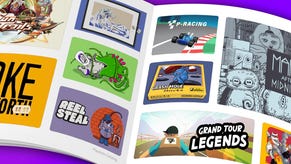PlayStation 4 promises a “simple” experience for developers and players
GDC 2013: Sony outlines the PlayStation 4's interface, controller, and social features
This morning at GDC 2013, Sony Senior Staff Engineer Chris Norden gave developers a look at what they should expect from the company's upcoming PlayStation 4 console. Norden first tackled the system and its interface, noting that while core gamers were first in Sony's mind, the blue ocean market has not been forgotten.
"The core gamers are our primary audience and are fundamental to PS4 gaming," said Norden. "They're the most engaged users and they're very important advocates for the platform. PS4 is architect-ed around their expectations. At the same time, we want to create a platform that can sail through a broad audience. The interface is designed to be fun, appealing, and accessible to the entire household."
Inside the PlayStation 4 Hardware
The name for the PlayStation 4 interface was revealed as the "Connected UX", leaving behind the Xross Media Bar and Live Area systems that debuted with the PlayStation 3 and PlayStation Vita respectively. Norden explained that Sony's "new paradigm is that everything and everyone is connected."
"We believe that with the PS4 generation even the traditional single-player experience becomes more of a connected, social experience," he added.
Sony has five principles that extend to the entirety of the PlayStation 4: Simple, Immediate, Social, Integrated, Personalize. The user experience must be simple, players should be able to access "frictionless" services and gameplay, sharing with friends is paramount, the system should connect easily to outside social networks and services, and each user's Connected UX should be directly applicable to their personal lives.
Norden then detailed the system's hardware, without delving directly into what specific parts comprised the system. The PlayStation 4 features a 64-bit x86-based architecture with low power and low heat, 8-cores, 8 hardware threads, all built into an "excellent general purpose" CPU.
"It's all the stuff you're used to if you've ever programmed for a PC," Norden said.
Norden also revealed an extended Direct X 11.1 featureset, a new asynchronous compute architecture, "greatly expanded shaders", and features "beyond" Direct X 11, OpenGL 4.0, and OpenCL. Sony's Compute allows developers to run arbitrary code on the GPU instead of the CPU, which benefits fluids, particles and post processing. Compute has access to the system's full set of "very expensive, very exotic" 8GB 256-bit GDDR5 unified memory. The system features two API: a low-level API that Norden said was "pretty much directly to the hardware" and a "Wrapper" API that is "very similar" to PlayStation 3 and PlayStation Vita graphics libraries.
"The point of Compute is to be able to take non-graphics code and run it on the GPU," he explained. "You can run hundreds or thousands, or even hundreds of thousands of parallel tasks on the GPU. Each task can be very small, but you're running so many at once that it gives you a lot of throughput."
The PlayStation 4 has a high-speed Blu-ray drive, which is three times faster than the PS3's Blu-Ray drive. Norden also said that a "very large" hard drive would be in every PlayStation 4. Norden said the system was built to be powerful, but easy to program for.
"You don't have to struggle with the architecture as much anymore. It's just there, it just works, it's in the background. You can really focus on being creative with your game. Better environments, better mechanics, cooler special effects."
The Dual Shock 4
Nordon then dived into the new DualShock 4 controller. The controller has the full compliment of DualShock buttons, but redesigned. While the L2/R2 triggers are still analog, the rest of the controller's buttons are now digital. Sony found that "almost nobody" used the analog buttons and system bandwidth was saved by switching to digital. The triggers have also been redesigned to prevent accidental presses when you lay the controller on a table.
The Share button featured in the previous PlayStation 4 announcement is the new system button and a second Options button replaces start/select functions. Norden said the analog sticks are tighter than they were on the DualShock 3, with a new surface material and shape for the sticks to prevent slippage.
The new touchpad is 2-point multitouch and doubles as a real button with a tactile click. The touchpad has an analog input with a resolution of 1920x900 and the PlayStation Vita's gesture library will transfer over to the PS4. The internal speaker is mono and the headset jack features stereo sound. Sony will be including a mono headset and microphone with every PlayStation 4.
The Dual Shock 4's new light bar replaces the port number LEDs on the DualShock 3, with player number now becoming player color. The colors match PlayStation face buttons: player 1 is blue, player 2 is red, player 3 is green, and player 4 is pink. Controllers can finally charge while PS4 on standby, and the light blinks while charging so players will also know the controller's power status. The light bar is a full-color-range LED and can change color for gameplay.
The PlayStation 4 Eye
The new PlayStation 4 Eye is the second part of the system's input interface and can track all four controllers with precise accuracy using the light bar. With the addition of rotational tracking due to the Dual Shock 4's accelrometer and gyroscope, developers have fine control over player tracking. The Eye is comprised of two color cameras with a resolution on 1280x800, though developers can lower the resolution to increase framerate. An array of four microphones can track player voice.
Sony expects developers to use the PlayStation Eye for face detection, player segmentation, and speech recognition, with the Eye remaining fully-compatible with the PlayStation Move. The company envisions a ton of use scenarios for the device, including walkthough videos, voice chat, video chat, voice/video messaging, killcams, and facial login. Norden brought up the example of using the Eye to track leaning in racing games and peaking around corners in first-person shooters.
Norden showed off an internal video demo showing different uses of the DualShock 4 and PlayStation 4 Eye. Two players played ping-pong on a virtual table morphed by the position of the controllers' light bars. Another demo showed a developer interacting with tiny robots inside the controller. Effects included shaking the robots by shaking the controller, covering light bar to leave the robots in pitch darkness, and flicking them outside the Dual Shock 4 using the touchpad.
The PlayStation 4's User Interface and Social Features
The next part of the presentation was on the PlayStation 4's graphical user interface, as shown in the previous system reveal. Norden stressed that the UI is not final and may change between now and launch. The UI includes up-to-date info about current games, alongside associated DLC, videos, and other personalized player data. It also features a digest view of the player's entire social network.
Sony presented an "improved friend system" based around the Share feature. The new friend system is split between a player's true name/profile and their PlayStation avatar and Online ID, not unlike Blizzard's RealID system for Battle.net. Norden stressed that releasing a player's true name was not enabled by default. Players can add friends through their true names via search or linking from Facebook. Both users must mutually agree to add each other via true names. The maximum number of friends on PlayStation Network has also been increased.
"If you already trust someone with your real name on another network and you import from that network, then we're going to assume that you want to trust them on the PlayStation Network as well. You can disable that if you don't want to share your true name for whatever reason," said Norden.
Sony's social plans are built around the Share button, which has dedicated hardware that's always recording the last several minutes of gameplay. A long press of the Share button takes screenshots without interrupting your game. Share also features a simple video editing suite, so players can upload a video or screenshot to Facebook, with uploading happening in the background.
"We hope it ushers in the new era of anybody being able to share video. Now it's more of a specialized thing where only the hardcore really want to stream and share. [With this] it's easy; anybody can do it," he said.
Second Screens: The PlayStation Vita and PlayStation App
Norden explained the two second-screen options for the PlayStation 4: remote play on the PlayStation Vita or the brand-new PlayStation App. No resources allocating is needed for Vita remote play and the option can be started at anytime. PlayStation 4 content is mirrored on the Vita screen and plays at native Vita resolution. PlayStation Vita system software will include mapping for Dual Shock 4 buttons that do not exist on portable.
The PlayStation App is coming for Android and iOS smartphones and tablets. Users can use the app to browse the PlayStation Network store and community pages. The PlayStation App will also act as second screen for games if developers choose to enable the feature, not unlike Microsoft's Xbox Smart Glass.
If players use the PlayStation App to purchase a game on the PlayStation Store, the title will begin downloading on their PlayStation 4. Sony is pushing a play-as-you-download option, with game data being split into multiple chunks. Users should be able to start playing their game when the minimum amount of data is downloaded, but this option is ultimately under developer control.
"We're hoping this is going to increase engagement and get people to really be less shy about content. It's going to be so much easier to try things; really get content to your system as soon as possible and not wait for it," said Norden.
"We want sharing to be so effortless that everybody does it without even thinking about it. We hope that the community really grows and people feel a strong sense of commitment even if they're not actively trying to participate in groups. It's going to become so much easier to see what your friends are doing that you feel more connected to them," he closed.
[Image via The Verge]









